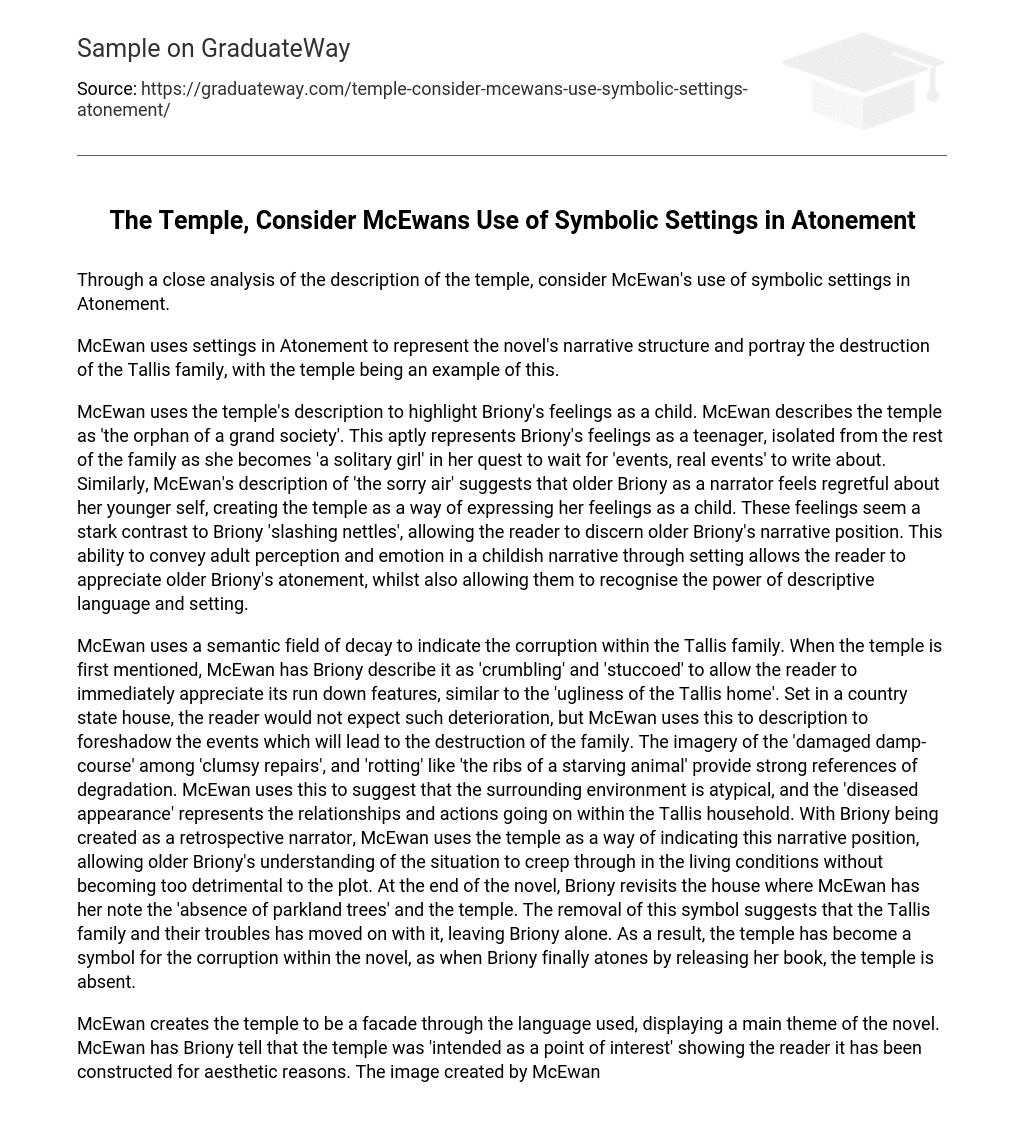Through a close analysis of the description of the temple, consider McEwan’s use of symbolic settings in Atonement.
McEwan uses settings in Atonement to represent the novel’s narrative structure and portray the destruction of the Tallis family, with the temple being an example of this.
McEwan uses the temple’s description to highlight Briony’s feelings as a child. McEwan describes the temple as ‘the orphan of a grand society’. This aptly represents Briony’s feelings as a teenager, isolated from the rest of the family as she becomes ‘a solitary girl’ in her quest to wait for ‘events, real events’ to write about. Similarly, McEwan’s description of ‘the sorry air’ suggests that older Briony as a narrator feels regretful about her younger self, creating the temple as a way of expressing her feelings as a child. These feelings seem a stark contrast to Briony ‘slashing nettles’, allowing the reader to discern older Briony’s narrative position. This ability to convey adult perception and emotion in a childish narrative through setting allows the reader to appreciate older Briony’s atonement, whilst also allowing them to recognise the power of descriptive language and setting.
McEwan uses a semantic field of decay to indicate the corruption within the Tallis family. When the temple is first mentioned, McEwan has Briony describe it as ‘crumbling’ and ‘stuccoed’ to allow the reader to immediately appreciate its run down features, similar to the ‘ugliness of the Tallis home’. Set in a country state house, the reader would not expect such deterioration, but McEwan uses this to description to foreshadow the events which will lead to the destruction of the family. The imagery of the ‘damaged damp-course’ among ‘clumsy repairs’, and ‘rotting’ like ‘the ribs of a starving animal’ provide strong references of degradation. McEwan uses this to suggest that the surrounding environment is atypical, and the ‘diseased appearance’ represents the relationships and actions going on within the Tallis household. With Briony being created as a retrospective narrator, McEwan uses the temple as a way of indicating this narrative position, allowing older Briony’s understanding of the situation to creep through in the living conditions without becoming too detrimental to the plot. At the end of the novel, Briony revisits the house where McEwan has her note the ‘absence of parkland trees’ and the temple. The removal of this symbol suggests that the Tallis family and their troubles has moved on with it, leaving Briony alone. As a result, the temple has become a symbol for the corruption within the novel, as when Briony finally atones by releasing her book, the temple is absent.
McEwan creates the temple to be a facade through the language used, displaying a main theme of the novel. McEwan has Briony tell that the temple was ‘intended as a point of interest’ showing the reader it has been constructed for aesthetic reasons. The image created by McEwan of it being perfectly placed ‘near enough to the water’s edge’ enabling it to cast ‘an interesting reflection in the lake’ emphasises its man-made qualities. It could be argued that this flawless placement echoes Briony’s aim to depict a journey of love and atonement. However, McEwan’s use of language as he describes how ‘from most perspectives’ the temple is ‘charmingly half obscured’ begins to reveal the premise of the novel – Briony chooses to construct or hide some details in her narrative.
It is not until part four where the novel’s last, and most honest perspective is revealed when Briony tells of how she has constructed Cecelia and Robbie’s relationship. McEwan has Briony’s narration hint that this is the case early on, telling that ‘tragedy had rescued the temple from being entirely a fake’. The fabrication surrounding the temple is confirmed when Briony revisits the house in her later years, stating how ‘the bright red facade’ had left ‘no reason to be nostalgic’. As a result, McEwan’s creation of the temple as a symbol of facade and fabrication gives a clear overview of his aim with the novel. His ability to manipulate settings and surroundings to depict corresponding feelings and actions within the narrative shows the power of writing – the reader is lulled into Briony’s world as created by McEwan.
In conclusion, the temple being used the depict corruption, fabrication and Briony’s feelings as a child shows the power of older Briony’s narration to place her adult feelings and knowledge to foreshadow what she creates later in the novel. The temple, and other settings in Atonement, are used by McEwan as symbols of Briony’s control over the novel.





